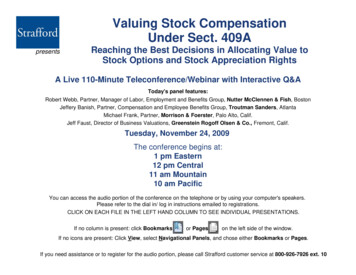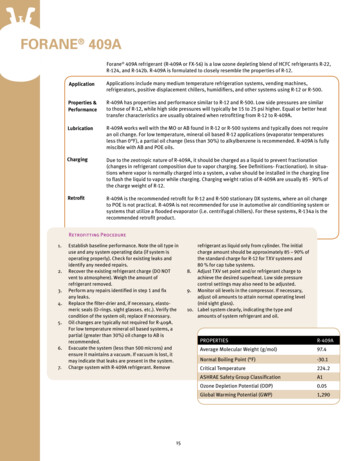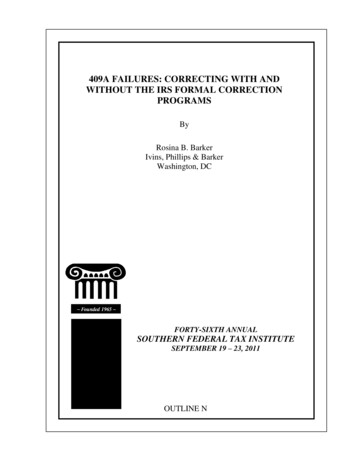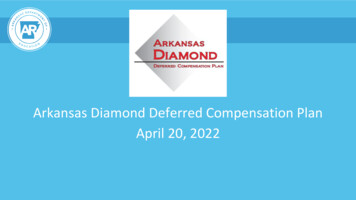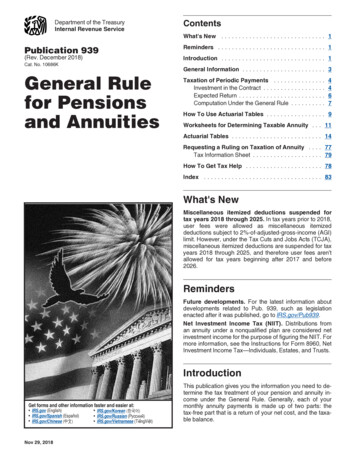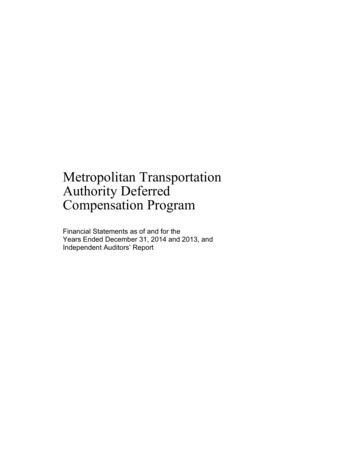
Transcription
Presenting a live 90-minute webinar with interactive Q&A409A Guidance on Nonqualified DeferredCompensation Plans: Compliance StrategiesImplications of Tax Reform, Definition of Payment, Exemptions, Permitted Payments,Remedies and MoreWEDNESDAY, MARCH 7, 20181pm Eastern 12pm Central 11am Mountain 10am PacificToday’s faculty features:Marshall Mort, Esq., Fenwick & West, Mountain View, Calif.Hans Andersson, Fenwick & West, SeattleThe audio portion of the conference may be accessed via the telephone or by using your computer'sspeakers. Please refer to the instructions emailed to registrants for additional information. If youhave any questions, please contact Customer Service at 1-800-926-7926 ext. 1.
Tips for Optimal QualityFOR LIVE EVENT ONLYSound QualityIf you are listening via your computer speakers, please note that the qualityof your sound will vary depending on the speed and quality of your internetconnection.If the sound quality is not satisfactory, you may listen via the phone: dial1-866-258-2056 and enter your PIN when prompted. Otherwise, pleasesend us a chat or e-mail sound@straffordpub.com immediately so we can addressthe problem.If you dialed in and have any difficulties during the call, press *0 for assistance.Viewing QualityTo maximize your screen, press the F11 key on your keyboard. To exit full screen,press the F11 key again.
Continuing Education CreditsFOR LIVE EVENT ONLYIn order for us to process your continuing education credit, you must confirm yourparticipation in this webinar by completing and submitting the AttendanceAffirmation/Evaluation after the webinar.A link to the Attendance Affirmation/Evaluation will be in the thank you emailthat you will receive immediately following the program.For additional information about continuing education, call us at 1-800-926-7926ext. 2.
Program MaterialsFOR LIVE EVENT ONLYIf you have not printed the conference materials for this program, pleasecomplete the following steps: Click on the symbol next to “Conference Materials” in the middle of the lefthand column on your screen. Click on the tab labeled “Handouts” that appears, and there you will see aPDF of the slides for today's program. Double click on the PDF and a separate page will open. Print the slides by clicking on the printer icon.
New 409A Guidance OnNonqualified DeferredCompensation Plans:Compliance Strategies for EmployeeBenefits CounselMarch 7, 2018
Proposed Section 409A Regulations Issued June 21, 2016 Comment period expires September 20, 2016 Taxpayers may rely on proposed regulations until finalregulations are published Intended to the clarify current final regulations Generally, not expected to require amendments to currentemployer plans6
Agenda Section 409A Background Clarifications in the Proposed Regulations to:– Exemptions– Compliant Payments– Corrections Program Other Clarifications Questions?7
Background8
What is Section 409A? Section 409A is intended as a way to regulate deferred compensationarrangements.– What is “deferred compensation”? A legally binding right – a promise – oral or written To pay compensation – cash, equity, benefits of many kinds To a current, former or future employee, director or consultant Such compensation is not guaranteed to be paid on or before March 15 ofthe following yearSection 409A was enacted, in part, in response to the practice of Enron executivesaccelerating the payments under their deferred compensation plans in order toaccess the money before Enron’s bankruptcy, and also in part in response to ahistory of perceived tax-timing abuse.9
What is Section 409A? Examples of “deferred compensation” Severance arrangements Change of control benefits – earn-out payments, 280G gross-ups Bonuses – performance, signing, retention, change of control Certain stock rights – discounted options, RSUs, guaranteed return awards Director compensation – fee deferrals, perquisites Salary deferrals Certain reimbursements Uncapped vacation accruals “Top-hat” deferred compensation plans and supplemental executiveretirement plans (“SERPs”) Each of these is a current legally binding right with compensation potentially to bepaid in a later taxable year Section 409A imposes penalties on “nonqualified deferred compensation plans”that are not (i) “exempt” from or (ii) “compliant” with Section 409A.10
Summary of 409A RulesExemption: Short-TermDeferral (on or before 15thday of third month of yearafter vesting)Must Comply and Pay On:If NDCP is notexempt, then it mustcomply with 409A.Exemption: Exempt StockRights or Stock Awards(options, RSUs that settleshortly after vesting,restricted stock) Watch for walkawayrights112.3.4.5.6.Fixed Date or Fixed Schedulefrom a vesting eventCICSeparation from ServiceDisabilityDeathUnforeseen EmergencyNote: 6 month delay for specifiedemployees upon separation fromservice.Exemption: Separation PayPlan (a.k.a. “2x2”) Watch “Good Reason”definition1.Exemption: QualifiedPlans (i.e. 401k Plans)Note: Watch for “toggling” withinthe same payment event, exceptupon a separation from servicefollowing a CIC.
What is Section 409A? Penalties for non-compliance:– All current and prior year “deferred compensation” of the same kind (evenproperly deferred amounts) may become immediately taxable if vested Federal, state and employment taxes– Additional 20% federal tax penalty– Federal interest on tax not paid at underpayment rate 1%– California imposes an additional 5% tax penalty plus interest Companies must withhold the ordinary income and employment taxes– No withholding obligation for the 20% penalty tax Companies must report failed deferrals and “409A income” on W-2 and possiblyamend prior years’ W-2s– Penalties to company for failure to timely withhold and report12
Proposed Regulations:Clarifications to Exemptions13
Extension of Short-Term Deferral Rule Current regulations:– A payment which must be made within 2 ½ months following the yearin which the payment vests is generally exempt from 409Arequirements (“short-term deferral”)– Payment may continue to qualify as a short-term deferral even if madeoutside the 2 ½ month period if: It is administratively impracticable for the company to make thepayment by the end of the 2 ½ month period Making the payment would jeopardize the company’s ability tocontinue as a going concern Making the payment would result in lost Section 162(m) deductionif deduction was not reasonably foreseeable at the time the legallybinding right arose14
Extension of Short-Term Deferral Rule Proposed regulations:– Payment may continue to qualify as a short-term deferral even if madeoutside the 2 ½ month period if the payment would violate federalsecurities laws or other applicable law.– Payment must be made as soon as reasonably practicable followingthe first date on which the company anticipates or reasonably shouldanticipate that making the payment would not cause a violation Potential application– Financial restatement that results in ineffective S-8 because publicfilings are no longer current15
Awards with Repurchase Rights forBad Behavior Current regulations:– Stock options and SARs (“stock rights”) granted with respect to“service recipient stock” may be exempt from 409A if certainconditions are met– “Service recipient stock” does not include stock that is subject to arepurchase or call right for a repurchase price less than the fair marketvalue of such stock. Proposed regulations:– Clarify that the definition of “service recipient stock” permitsrepurchases at less than fair market value upon: The service provider’s involuntary separation from service forcause; or The occurrence of a condition within the service provider’s control– Example: Non-compliance with a non-compete or non-disclosure agreement16
Awards to Prospective ServiceProviders Current regulations:– Stock rights may only be granted to employees and consultants whoare providing services on the date of grant to the issuing company orits controlled subsidiaries Problematic in employment negotiations if issuer wants to grantan equity award prior to the employee’s start date Proposed regulations:– Modify the definition of “eligible issuer of service recipient stock” toinclude any entity for which is reasonably anticipated that the serviceprovider will begin providing services within 12 months after the dateof grant, and the person actually begins providing services within 12months after the date of grant17
Awards to Prospective ServiceProviders Potential Application:– NSOs granted to prospective service providers are not automaticallydisqualified from exemption under Section 409A– However, awards to prospective employees and consultants may stillnot permitted under: ISO rules (see IRC 422(a)(2)) Certain securities laws (see Rule 701(c) of the Securities Act) Many equity plans18
Separation Pay Plan Exception Current regulations:– Payments upon an involuntary separation from service (or a voluntaryseparation from service pursuant to a qualifying window program) canbe exempt from Section 409A if: The separation pay does not exceed two times the lesser of (1) theservice provider’s annualized compensation for the year precedingthe year of termination and (2) the 401(a)(17) limit ( 265,000 in2016), and The payments are made by the end of the second year followingthe year of termination Proposed regulations:– Clarify that, for service providers whose employment begins and endsduring the same taxable year, the service provider’s annualizedcompensation for the year of termination should be used to computethe dollar threshold19
Separation Pay Plan Exception Remember: the separation pay plan exception only applies to actual“involuntary termination” – service provider was willing and able to work Death and disability excluded Resignation for “good reason” may qualify if the definition of“good reason” is consistent with safe harbor definition Safe harbor definition of “good reason”:– Only certain IRS-specified material negative changes to the employmentrelationship may trigger the resignation right;– The employee must provide the employer with written notice specifying the“good reason” condition within ninety days following its initial existence;– The employer must have at least a thirty days to cure the condition and avoidpaying severance benefits; and– Resignation must occur within two years after initial event giving rise to goodreason.20
Separation Pay Plan ExceptionSpecifically Listed Safe Harbor “Good Reason” Triggers: Material diminution in annual base compensation– NOT bonus or benefits – guaranteed base compensation Material diminution in authority, duties or responsibilities– NOT title Material diminution in the authority, duties or responsibilities of thesupervisor to whom employee is required to report, including arequirement that employee report to a corporate officer or employeeinstead of the board of directors Material diminution in budgetary authority Material change in geographic work location– Best to phrase as increase in one-way commute that exceeds aspecified distance Any other action or inaction that constitutes a material breach by theemployer of the agreement under which the employee provides service.21
Transaction-Based CompensationException Current regulations:– Transaction-based compensation payments are payments related tocertain types of changes in control (including escrow and earn-outpayments) that are: Made because a company purchases its stock or a stock right heldby a service provider or Calculated by reference to the value of the company’s stock.– Transaction-based compensation may be paid on the same scheduleand under the same terms as apply to other stockholders in thechange in control generally But, all payments must be made within 5 years following thechange in control– Transaction-based compensation is treated as complying with Section409A (instead of being exempt from Section 409A)22
Transaction-Based CompensationException Proposed regulations:– Clarify that the transaction-based compensation exception alsoapplies to ISOs and exempt stock rights Option spread may be paid out over time on the same schedule aspayments to stockholders, so long as all payments are made withinfive years after the change in control– Do not address whether option spread may be paid in cash after thechange in control under original vesting schedule23
Proposed Regulations:Clarifications to Compliant Payments24
409A: Compliant Payments“Six Triggers” Structuring payments to be compliant with Section409A can be complex. The basic premise is thatpayments can be paid upon one of six eparation from serviceSpecified time or eventChange in controlUnforeseeable emergency25
409A: Compliant PaymentsIt is Not Easy to Change 409A Compliant Payments Compliant payments are effectively carved in stone– Restricted ability to accelerate– Restricted ability to defer– Very few exceptions26
409A: Compliant PaymentsProposed Regulations The proposed regulations introduce additional flexibility to accelerate or defercertain compliant payments of deferred compensation.– Payments due to death of a service provider– Payments to beneficiaries due to beneficiaries’ death, disability orunforeseeable emergency– Compliance with bona fide foreign ethics laws or conflicts of interests laws– Compliance with federal debt collection laws The proposed regulations also clarify certain ambiguities relating to payments inconnection with separations from service.27
409A: Compliant PaymentsProposed Regulations - Death of Service Provider A source of frustration with the current regulations is the practicalities ofmaking timely payment of deferred compensation to a beneficiary orestate following a service provider’s death, and particularly if the deathoccurs late in the calendar year.– The current regulations generally require that if deferred compensation is tobe paid upon employee’s death, it must be paid in the same taxable year asthe employee’s death or, if later, by the 15th day of the third calendar monthfollowing the employee’s death, as long as the recipient of the compensationis not able to designate the year of the payment. If payment spans twotaxable years, it must be made within 90 days of death.– The proposed regulations provide more time to make these payments: Payment may be made until December 31 of the first year following the year of theemployee’s death. The recipient may have the right to designate the taxable year of payment withoutviolating Section 409A.28
409A: Compliant PaymentsProposed Regulations - Death/Disability/Unforeseeable Emergency ofBeneficiary Another source of frustration with the current regulations is abeneficiary’s inability to accelerate (and therefore access) deferredamounts scheduled to be paid over an extended period of time. The proposed regulations permit acceleration of payment of deferredcompensation to a beneficiary:– Death, disability or unforeseeable emergency of a beneficiary (who has become entitledto a payment due to a service provider's death) as a potentially earlier or interveningpayment event will not violate the prohibition on the acceleration of payments. The proposed regulations provide that a plan can be amended to allow apayment, or the payment can be made without amending the plan at anytime during period described on the prior slide.29
409A: Compliant PaymentsProposed Regulations – Foreign Ethics/Conflicts of Interest Laws The current regulations allow employers to accelerate the payment ofdeferred compensation to comply with a foreign ethics or conflicts ofinterest law, but only with respect to foreign earned income from sourceswithin the foreign country that promulgated the law. The proposed regulations remove the restriction on the types ofcompensation that qualify for acceleration.– Any deferred compensation may be accelerated as reasonablynecessary to comply with a bona fide foreign ethics or conflicts ofinterest law.30
409A: Compliant PaymentsProposed Regulations – Federal Debt Collection The current regulations provide some ability to accelerate payment inorder to pay a service provider’s debt (generally limited to 5,000 forcertain types of debt). This limited offset right has been deemed to be inconflict with certain federal debt collection laws. The proposed regulations expand this offset right. Accelerated paymentsare permitted to the extent “reasonably necessary” to comply with federaldebt collection laws.31
409A: Compliant PaymentsPlan Terminations/Liquidations Under the current regulations, a deferred compensation plan may beterminated and liquidated and payment thereunder accelerated if, amongother things: (i) the service recipient terminates and liquidates all plans itsponsors that would be aggregated with the terminated plan if the sameservice provider had deferred compensation under all such plans; and (ii)the service recipient does not, for three years, adopt a new plan thatwould be aggregated with the terminated and liquidated plan if the sameservice recipient participated in all such plans.– The current regulations list nine types of nonqualified deferred compensationplans under the plan aggregation rules.– Some questioned whether all plans of the same type that are sponsored bythe service recipient must be terminated, or only plans of the same type inwhich the service recipient participated.32
409A: Compliant PaymentsPlan Terminations/Liquidations The proposed regulations provide that acceleration of payment under thisrule is permitted only if the service recipient terminates and liquidates allplans of the same category that the service recipient sponsors, not only allplans of the same category in which a particular employee participates. The proposed regulations also clarify that the three year ban on adoptinga new plan of the same category as the terminated and liquidated planapplies regardless of which service providers participate in the plan.33
409A: Compliant PaymentsProposed Regulations - Separation from Service (Clarification) The current regulations provide that the parties to an asset sale mayspecify whether a service provider of the seller is treated as separatingfrom service if the service provider provides service to the buyer after andas a result of the sale. The proposed regulations clarify that this provision only relates to actualasset sales. It does not apply to stock sales that are treated as asset salesunder a Section 338 election for corporate income tax purposes.– “[E]mployees do not experience a termination of employment, formal or otherwise” in astock sale, regardless of the tax treatment. This clarification has immediate effect.34
409A: Compliant PaymentsProposed Regulations - Separation from Service (Technical Correction) The current regulations generally provide that a separation from serviceoccurs if the facts and circumstances indicate that the employer andemployee reasonably anticipate that:– no further services are to be performed or– the level of services to be performed (whether as an employee or an independentcontractor) would permanently decrease to no more than 20 percent of the averagelevel of services (as an employee or an independent contractor) over the preceding 36months. The proposed regulations clarify that this rule applies to a service providerwhose status changes from employee to independent contractor. If an employee becomes an independent contractor but does not have a separationfrom service at such time, the service provider will have a separation from service in thefuture when he or she has a separation from service based on the rules that apply toindependent contractors (i.e., expiration of the consulting contract(s), if expiration is agood faith and complete termination of the consulting relationship).35
Definition of Payment36
Definition of “Payment” Existing rules were varied in defining “payment”Proposed regulations offer a definition of payment that is “generally applicable forall purposes under 409A to determine when a payment is made”:PaymentA transfer of cashA contribution to trust, orcreation of beneficial interest in atrust, which is includable inincome under 402(b)Not a PaymentAn option grant with noreadily ascertainable FMVAny event that results inA transfer or cancellation ofinclusion of income under deferred amount for welfare oreconomic benefit doctrine other nontaxable benefitsA transfer of unvestedproperty not yet includable inincome under Section 83A transfer of propertyincludable in incomeunder Section 83Transfers /creations ofinterest in trust not yetincluded in income under402(b)An amount included in incomeunder 457(f)(1)(A)37
Section 83 Property as Payment Some practitioners took the view that the transfer of unvested stock withno 83(b) election was a “payment” within 409A, even though gains werenot yet includable in income. The proposed regulations foreclose that position with immediate effect,stating that practitioners may no longer contend a “payment” occurs uponthe transfer of unvested stock with no 83(b) election. Example:– In 2016, the Company and executive make a deferral election to defer a bonus for 2017to May 1, 2018.– In 2017, the parties seek to amend the arrangement to provide for payment on of May1, 2018, with the executive having the right to elect between an immediate cashpayment or a number of shares equal to the fixed bonus, which will vest ratably over 2more years if he remains in service.– This would now be a clear violation of 409A, as a subsequent election deferral would beneeded. The proposed regulations foreclose the argument that the payment timingremained the same, unless an 83(b) election is to be made on the shares.38
Profits Interests as Payments? In the LLC context, it may not be necessary for recipients of profitsinterests to file an 83(b) election, in reliance on Rev Proc 93-27.– A profit interest, properly constituted at its liquidation value, held for twoyears, and where the holder is treated as a partner, is not taxable at grant, orat later vesting. The IRS previously issued proposed regulations to permit the filingof Section 83(b) elections on profit interests. The guidance remainsproposed. If an 83(b) election is not filed, does payment for 409A purposesoccur at the profit interest grant or upon later vesting?39
Cancellation for Options Another ambiguity is whether nonqualified deferredcompensation compliant with 409A could be cancelled for anearlier payment of an option. The proposed regulations would consider a transfer of anontaxable benefit to be payment, but also provide a clearexception for options without a readily ascertainable FMV. Since an “option” is not a payment under the proposedregulations, is this an impermissible acceleration of thecompliant payment?40
Proposed Regulations:Clarifications to 409A CorrectionsPrograms41
Section 409A Correction Programs Section 409A offers various correction opportunities for nonqualified deferrals thatcontain operational or documentary errors. Operational: Improper accelerations or deferrals under 409A or stock options bearing a discount;Documentary: Impermissible definitions of permitted payment events; failure to provide six monthdelay; impermissible acceleration allowed; no payment event is a permissible payment event, etc.The 409A correction programs are burdensome, in some cases, requiring noticesto service providers and the IRS, imposing penalties, and limiting relief to noninsiders. Each type of correction should be evaluated for its own eligibility criteria.These are referred to as the “Correction Conditions.” A discounted option can be corrected by upward adjustment of the exercise price; notice ofcorrection must be provided to the IRS, and if the correction occurs in the year after the grant,also to the service provider. Correction ability phases out after close of year of grant forinsiders and otherwise upon close of year after grant. Notice 2008-113A plan contains no permissible payment trigger. Here, if correction is made prior to payment,50% of the vested amount is subject to 409A penalties (and the tax is paid and reported on W2). Service provider and service recipient must attach correction notices to each of their taxreturns. Notice 2010-642
What if Amounts are Unvested? Practitioners took the position that corrections may be made freely ofamounts that would be unvested for the entire year of correction (i.e.,amounts subjected to a substantial risk of forfeiture). BUT: Correction of unvested amounts is restricted where the amount isnot subject to a substantial risk of forfeiture at all times during the taxableyear of correction.43
Recent Ruling On PointOffice Chief Counsel Memo No. 201518013 (May 2015) Facts: In 10/01, Company enters into a retention agreement with executive,promising that if he is employed on 10/03, he will get a retention bonus. Theagreement allows payment in two equal installments on 10/04 and 10/05, butthat the Company may pay in a lump sum on 10/04 if it so chooses. On 6/03,the Company amends the bonus to remove the impermissible accelerationability, and the executive earned the bonus and was paid on 10/04 and 10/05. Holding: The correction is ineffective. In year 1 and 2, while the award was unvested for the entirety of thoseyears, the executive has no income inclusion due to 409A. In year 3, the entire deferred amount vests and is included in income inyear 3. The correction to enact a deferral was ineffective for tax purposes.44
Section 409A: Proposed RegulationsLimit When Corrections May Occur IRS was concerned that practitioners were fabricating or reading errors into documents inorder to change the time/form of payments of unvested payments.Under the proposed regulations, an otherwise unvested amount is deemed to be vested(and thus ineligible for correction and includable in income under 409A) if :– There is a change in the time/form of payment not otherwise permitted by 409A wherethe service provider has not made a reasonable good faith determination that (i) theoriginal provision failed to meet the 409A requirements and (ii) the change is necessaryto bring the plan into compliance; or– The intended correction is part of a pattern or practice of changing the time or form ofpayment with respect to unvested deferred amounts. Evidence of a pattern or practiceincludes (but is not limited to) whether substantially similar failures : are promptly corrected upon discovery; have occurred as to unvested amounts more frequently than for vested amounts; occur more frequently as to newly adopted plans; appear intentional, numerous; repeat past failures that have since been corrected.45
Section 409A: Proposed RegulationsLimit How Corrections May Occur The proposed regulations also limit the manner of correcting amounts entirelyunvested in the tax year of correction.An amount unvested will be deemed vested (and thus ineligible for correction andincludable in income under 409A) if:– The correction method is not consistent with the applicable correctionmethod (if one exists) set forth in applicable guidance; or– Substantially similar failures under other plans of the service recipient are notcorrected in substantially the same manner.While the correction method must be consistent with the IRS correction guidance,the Correction Conditions do not apply (e.g., notice, inclusion of penalties, phasingout of ability to correct, eligibility).46
Example of NewCorrection Protocol Example: In year 1, a bonus plan provides for payment on any change incontrol, including a dissolution or IPO, occurring in year 4 or thereafter, solong as the employee is in service at the end of year 3. Assuming thechange in control is not itself subject to a substantial risk of forfeiturebecause it is includes a dissolution. The Company seeks to correct thedefinition of change in control to make it 409A compliant.47
Answer Correction After Vesting or in Year of Vesting (i.e., in Year 3-4): Notice 2010-6would permit the correction. Notice would be provided to the IRS and theimpacted service provider. If the correction is made in year 3, and an IPO occurs inyear 4 and no other change in control event occurs, the service providers face apenalty of 25% income inclusion of the amount deferred. This is because Notice2010-6 imposes a penalty if the original non-compliant event occurs within oneyear of correction.Correction Before Year of Vesting (i.e., in Year 1-2): If the Company corrects in year2, while unvested, the Company can do so by imposing a 409A compliant changein control definition. None of Correction Conditions apply; however, under thenew guidance, the Company may not amend the award to provide payout on adifferent permissible event (e.g., on a separation from service).– This assumes the Company has in good faith determined the error to exist andthe corrected plan does not fit within a pattern or practice of similarcorrections.– This assumes the Company has corrected other similar arrangements underthis same approach.48
And then a Nuanced Example Example: An executive’s employment agreement provides that if he hasbeen in continuous service for five years, he will vest in a separationbonus. His separation bonus will be paid to him at any time at his electionduring the three years following his separation from service. Error: This Company finds an error in allowing the service provider tochange the time or form of payment following a permissible paymentevent.49
Answer Amendment: In year 3 of a participant’s service, while unvested, the Companydecides to revise the arrangement to require payment on the separation fromservice.409A Implications of Proposed Regulations:– Under the current regula
-What is "deferred compensation"? A legally binding right - a promise - oral or written To pay compensation - cash, equity, benefits of many kinds To a current, former or future employee, director or consultant Such compensation is not guaranteed to be paid on or before March 15 of the following year


